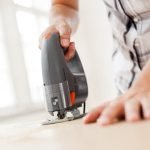Are you tired of poor cell phone reception in your home? In this article, we will discuss how to improve cell phone reception in your home. Having strong and reliable cell phone reception is crucial for staying connected, whether it’s for work, staying in touch with loved ones, or accessing essential services. Poor cell phone reception can impact communication and productivity, making it essential to address any issues you may be experiencing.
There are various factors that contribute to poor cell phone reception at home, ranging from distance from the nearest tower to interference from physical obstructions. Understanding these causes can help you identify potential solutions to improve your signal strength. Additionally, assessing your current cell phone reception is important in pinpointing areas with weak or no signal within your home. By assessing these areas, you can implement targeted strategies for improvement.
In the subsequent sections of this article, we will provide practical tips and DIY solutions for improving cell phone reception in your home. From repositioning your phone for better reception to exploring carrier-specific solutions and tech upgrades, there are numerous approaches you can take to ensure consistent and reliable cell phone reception at home. Stay tuned as we delve into each of these strategies in detail to help you achieve better connectivity in your living space.
Causes of Poor Cell Phone Reception at Home
One of the primary causes of poor cell phone reception at home is the distance from the nearest cell phone tower. The farther your home is from a tower, the weaker the signal strength will be. Additionally, physical barriers such as mountains, hills, or tall buildings can obstruct the signal and result in poor reception.
Another factor contributing to weak cell phone signal is interference from electronic devices within your home. Appliances like microwaves, cordless phones, and even baby monitors can disrupt cellular signals, causing dropped calls and slow data speeds. Understanding these potential sources of interference can help in addressing reception issues effectively.
It’s important to assess common issues that could be impacting cell phone reception in specific areas of your home. Identifying dead zones and areas with poor reception will allow you to target those areas when implementing solutions for improving cell phone signal. Conducting a thorough assessment can help pinpoint problem areas and strategize on how to improve the overall cell phone reception within your home.
Assessing Your Current Cell Phone Reception
When it comes to improving cell phone reception in your home, the first step is to assess the current strength of your signal. Understanding where you have strong reception and where you experience dead zones will help you target specific areas for improvement. Here are some ways to evaluate your current cell phone reception:
- Use a signal strength app: There are various apps available for both Android and iPhone devices that can provide detailed information about your cell phone signal strength. These apps can show you the exact signal strength in decibels (dBm) and help identify areas with poor reception.
- Conduct a call quality test: Make several test calls throughout your home and take note of any dropped calls or instances of poor call quality. This will give you a sense of which areas need the most attention when it comes to improving cell phone reception.
- Check for dead zones: Walk around your home while monitoring the signal bars on your phone. Take note of any areas where the signal weakens or drops off completely, as these are likely dead zones that need to be addressed.
By thoroughly assessing your current cell phone reception, you can pinpoint problem areas and determine the best strategies for improving signal strength in your home.
Identifying dead zones and areas with poor reception in your home is crucial for implementing effective solutions. By understanding where the weakest signal spots are located, you can take targeted action to improve overall cell phone reception throughout your home. Whether it’s repositioning your phone, investing in a signal booster, or exploring carrier-specific solutions, knowing where improvement is needed will maximize the effectiveness of any steps taken to enhance cell phone reception within your home.
Tips for Improving Cell Phone Reception
One simple and immediate way to improve cell phone reception at home is by optimizing the positioning of your phone. In areas with weak signal, holding your phone in a specific orientation or placing it on a flat surface can make a difference. Experiment with different positions and locations within your home to find the spot that offers the strongest reception.
Using Signal Boosters or Amplifiers
For a more comprehensive solution, consider investing in a signal booster or amplifier. These devices work by capturing an existing cellular signal, boosting it, and then rebroadcasting it within your home. This can significantly improve the strength and quality of your cell phone reception in areas where the signal is typically weak.
Exploring Wi-Fi Calling and Other Carrier Services
Many carriers offer services such as Wi-Fi calling, which allows you to make and receive calls over a Wi-Fi network instead of relying solely on cellular signals. This can be particularly helpful in areas with poor cell phone reception at home. Additionally, some carriers may provide Femtocells or Microcells, which are small base stations that can improve coverage within a specific area. Be sure to explore these carrier-specific solutions to enhance your cell phone reception at home.
DIY Solutions for Improving Cell Phone Reception
When dealing with poor cell phone reception at home, there are several do-it-yourself solutions that can help improve the signal strength. One of the most popular DIY methods is creating a homemade cell phone signal booster using household items such as aluminum foil, a soda can, or a baking pan. By following online tutorials and simple instructions, it is possible to amplify the cell phone signal in areas of your home where reception is weak.
Another DIY solution involves reconfiguring your home layout for better signal distribution. This can be achieved by strategically placing furniture and other objects that may be causing interference with the cell phone signal. By identifying dead zones and areas with poor reception in your home, you can make adjustments to improve overall signal coverage.
In addition to these DIY methods, it’s also important to consider utilizing carrier-specific solutions for improving cell phone reception. Different carriers offer various services and devices aimed at boosting signal strength within homes. Some examples include Wi-Fi calling and network extenders provided by specific carriers. By exploring these options, homeowners can find the most suitable solution for their particular situation.
| DIY Solutions | Benefits |
|---|---|
| Homemade Signal Booster | Amplifies cell phone signal using common household items |
| Home Layout Reconfiguration | Better signal distribution without additional equipment |
| Carrier-Specific Solutions | Certain services or devices from carriers designed to enhance signal strength |
Utilizing Carrier-Specific Solutions
When dealing with poor cell phone reception at home, it’s important to consider the solutions offered by your specific cell phone carrier. Different carriers provide their own set of services and options to improve signal strength and overall call quality. Here are some carrier-specific solutions to explore:
1. Understanding carrier-specific solutions: Each carrier may offer their own unique solutions for improving cell phone reception. This can include signal boosters specifically designed for their network, as well as services such as Wi-Fi calling that allow you to make calls over a Wi-Fi connection instead of relying solely on cellular signal.
2. Exploring Wi-Fi calling and other carrier services: Many carriers now offer Wi-Fi calling as an option for customers with poor cell phone reception at home. This feature allows you to make and receive calls using a Wi-Fi network instead of cellular signal, which can significantly improve call quality in areas with weak reception.
3. Contacting your carrier for assistance: If you’re experiencing consistently poor cell phone reception at home, it’s worth reaching out to your carrier’s customer service team to see what specific solutions or recommendations they can provide. They may be able to offer personalized advice or even send a technician to assess the situation and provide targeted solutions.
Overall, exploring the carrier-specific solutions available to you can be a crucial step in improving cell phone reception at home. By taking advantage of the resources and services offered by your specific carrier, you can work towards ensuring consistent communication and connectivity within your household.
Tech Upgrades for Better Cell Phone Reception
When experiencing consistent issues with cell phone reception at home, it might be time to consider tech upgrades to enhance the signal strength and overall connectivity. One of the most effective tech upgrades for improving cell phone reception is to upgrade to a newer phone with better antenna performance. Newer models often come equipped with advanced technology that can boost signal reception, especially in areas with weak coverage.
Another option for tech upgrades is exploring options for adding an external antenna to your home. These antennas are specifically designed to capture and amplify cellular signals, providing a more reliable connection for voice calls and data usage. External antennas can be installed on rooftops or exterior walls of your home, significantly improving reception in dead zones and areas with poor signal quality.
In addition to upgrading your phone or adding an external antenna, you may also want to consider investing in a signal booster or amplifier. These devices work by capturing existing cellular signals outside of your home, amplifying them, and then rebroadcasting the enhanced signal within the house. This helps to overcome obstructions or distances from cell towers, resulting in improved cell phone reception throughout your home.
| Tech Upgrade Option | Benefits |
|---|---|
| Newer Phone | Better antenna performance, improved signal reception |
| External Antenna | Amplifies cellular signals, provides reliable connection |
Final Thoughts
In conclusion, ensuring consistent cell phone reception at home is crucial for maintaining effective communication and connectivity. The impact of weak cell phone reception on productivity and the ability to stay connected with family and friends cannot be understated. As outlined in this article, there are various factors that contribute to poor cell phone reception, but there are also practical steps that can be taken to improve the signal strength within your home.
By assessing your current cell phone reception and identifying areas with poor signal, you can strategically position your phone or consider using a signal booster or amplifier to enhance the signal strength. Additionally, exploring DIY solutions such as creating a homemade cell phone signal booster using household items or reconfiguring your home layout for better signal distribution can make a significant difference in improving reception.
Furthermore, it is important to take advantage of carrier-specific solutions such as Wi-Fi calling and other services offered by your mobile provider. In some cases, tech upgrades such as upgrading to a newer phone with better antenna performance or adding an external antenna to your home may also be worthwhile investments for achieving better cell phone reception.
Ultimately, consistent communication and connectivity at home are essential, and by implementing the tips and strategies outlined in this article, you can significantly improve the cell phone reception within your home.
Frequently Asked Questions
How Can I Improve My Mobile Signal Strength Indoors?
Improving mobile signal strength indoors can be done in several ways. One way is to use a signal booster, which amplifies the existing signal and improves coverage within the building.
Another option is to utilize Wi-Fi calling, if supported by your carrier, to make calls over a Wi-Fi network instead of relying solely on cellular signal. Additionally, positioning the phone near a window or exterior wall can sometimes improve reception.
How Can I Boost My Cell Phone Signal in My House?
Boosting cell phone signal in your house can be achieved by using a few different methods. Installing a femtocell or microcell device provided by your carrier can create a mini-cell tower within your home, improving signal strength.
Utilizing a Wi-Fi network for calls and texts through Wi-Fi calling can also help boost cell phone signal indoors. Moreover, ensuring that there are no obstructions blocking the signal from entering the house (such as metal roofs or walls) can also make a difference.
Why Is My Phone Reception So Bad in My House?
Poor phone reception inside a house can be attributed to various factors. The construction materials of the building, such as metal siding or energy-efficient windows, can block cellular signals from entering effectively.
Additionally, geographic location and proximity to cell towers play a role in determining reception quality indoors. Other factors like interference from electronic devices and the layout of the building itself can also contribute to bad phone reception inside a house.

I’m thrilled to have you here as a part of the Remodeling Top community. This is where my journey as an architect and remodeling enthusiast intersects with your passion for transforming houses into dream homes.





